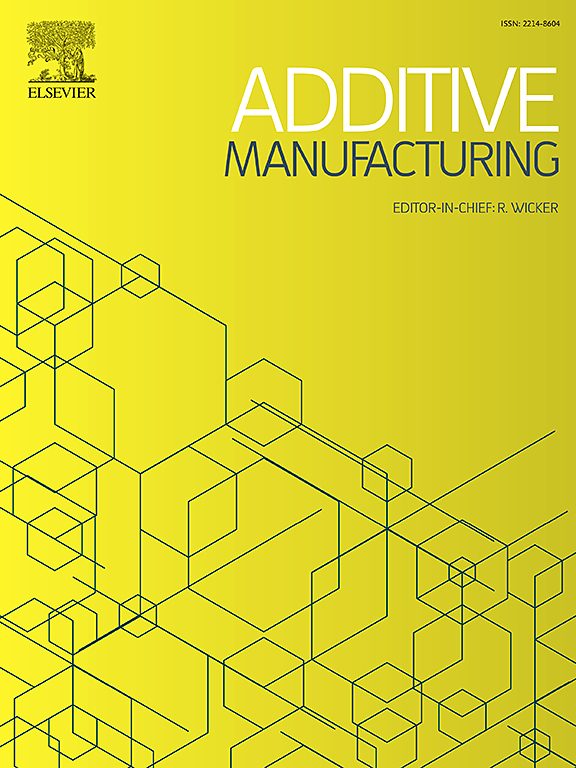IF 10.3
1区 工程技术
Q1 ENGINEERING, MANUFACTURING
引用次数: 0
摘要
激光直接能量沉积(LDED)和激光粉末床熔融(LPBF)是航空航天等关键领域使用的两种典型的金属激光增材制造(AM)工艺。然而,其零件质量的稳定性仍然具有挑战性。增材制造过程中熔池的温度对制造零件的质量有很大影响。因此,迫切需要在高温、小面积熔池的原位监测技术方面取得突破。为应对这一挑战,本文提出了一种使用光场(LF)相机进行原位熔池温度场监测的多眼监测方法。首先,建立光场子孔径拜耳模型(LFSBM),提取红、绿、蓝(R、G、B)波长的熔池图像。利用黑体炉校准低频相机的相对光谱响应比,根据双波长理论,从 R、G 和 B 波道的两幅图像中得出熔池的温度场。对 B 和 G、R 和 B 以及 R 和 G 信道组合的相对光谱响应比进行线性拟合,得出的均方根误差分别为 76.34 K、62.24 K 和 78.66 K。经黑体炉验证,最高温度的平均误差为 1.03%,在 2973.15 K、3073.15 K 和 3273.15 K 温度下的温度备案误差小于 3%。校准了 LPBF 同轴系统对波长强度的影响。发现温度图与黑体炉之间的轮廓误差小于 1.4%。利用 LDED 和 LPBF 设备对高熵合金和 Ti6Al4V 合金进行了实验,分析了长度、宽度和最高温度的演变。所提出的方法简化了测量过程并允许无限的温度范围,为 AM 过程中原位熔池温度监测提供了一种开创性的方法。本文章由计算机程序翻译,如有差异,请以英文原文为准。
In-situ multi-eye monitoring of melt pool temperature field in laser additive manufacturing by light field camera
Laser direct energy deposition (LDED) and laser powder bed fusion (LPBF) are two typical metal laser-based additive manufacturing (AM) processes used in critical fields such as aerospace and aviation. However, the stability of their part quality remains challenging. The temperature of the melt pool during the AM process significantly influences the quality of the manufactured parts. Therefore, breakthroughs in in-situ monitoring technology for high-temperature, small-area melt pools keep an urgent need. To address this challenge, this paper proposes a multi-eye monitoring method using a light field (LF) camera for in-situ melt pool temperature field monitoring. Initially, a LF sub-aperture Bayer model (LFSBM) is established to extract melt pool images at red, green, and blue (R, G, and B) wavelengths. By calibrating the LF camera’s relative spectral response ratio using the blackbody furnace, the melt pool’s temperature field is derived based on dual-wavelength theory from two images at R, G, and B channels. Linear fitting of the relative spectral response ratio for channel combinations of B and G, R and B, and R and G yielded root mean square errors of 76.34 K, 62.24 K, and 78.66 K, respectively. The mean error for maximum temperature was verified to be 1.03 %, and less than 3 % for temperature filed at temperatures of 2973.15 K, 3073.15 K, and 3273.15 K by the blackbody furnace. The influence of coaxial system of LPBF on wavelength intensity was calibrated. The contour error between the temperature map and the blackbody furnace was found to be less than 1.4 %. Experiments were conducted on high-entropy alloy, and Ti6Al4V alloys manufactured by both LDED and LPBF equipment, and evolution of length, width, and maximum temperature were analyzed. The proposed method simplifies the measurement process and allows for an unlimited temperature range, providing a groundbreaking approach for in-situ melt pool temperature monitoring during the AM process.
求助全文
通过发布文献求助,成功后即可免费获取论文全文。
去求助
来源期刊

Additive manufacturing
Materials Science-General Materials Science
CiteScore
19.80
自引率
12.70%
发文量
648
审稿时长
35 days
期刊介绍:
Additive Manufacturing stands as a peer-reviewed journal dedicated to delivering high-quality research papers and reviews in the field of additive manufacturing, serving both academia and industry leaders. The journal's objective is to recognize the innovative essence of additive manufacturing and its diverse applications, providing a comprehensive overview of current developments and future prospects.
The transformative potential of additive manufacturing technologies in product design and manufacturing is poised to disrupt traditional approaches. In response to this paradigm shift, a distinctive and comprehensive publication outlet was essential. Additive Manufacturing fulfills this need, offering a platform for engineers, materials scientists, and practitioners across academia and various industries to document and share innovations in these evolving technologies.
 求助内容:
求助内容: 应助结果提醒方式:
应助结果提醒方式:


